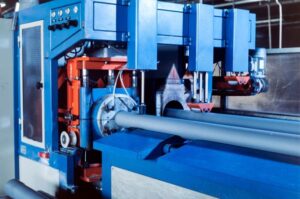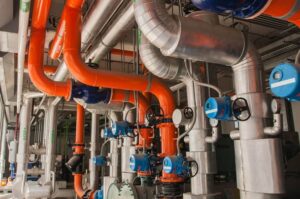A look at our Conferences

"Join the Discussion on the Latest Developments in Plastic Pipe Technology."
OUR WORK





View Our Most Recent Blogs
Living in a Plastic World: The Truth Behind Our Dependence and Dilemma
The ubiquity of plastic in our lives is a testament to its versatility and durability. From the cars we drive to the credit cards we swipe and the plastic pipes in our homes, this material has firmly embedded itself in our daily lives and the broader infrastructure of the 21st century. But alongside this usefulness comes a weighty responsibility for managing its impact on our planet.
Plastics have become an essential material in the modern age, playing a critical role in various sectors such as packaging, automotive, electronics, and healthcare. However, the benefits of plastic come at an environmental cost. This article aims to delve deeper into how plastics impact our world by exploring their advantages and highlighting sustainable practices that should be incorporated within this industry for its long-term survival.
The All-Pervasive Plastic
Derived from the Greek word plastikos, which means ‘capable of being shaped or molded,’ plastic’s adaptable nature has shaped the 21st century in countless ways. Since the first fully synthetic plastic – Bakelite – was developed in the early 20th century, plastic’s use and demand have grown exponentially. Its characteristics, such as lightness, durability, and moisture resistance, make it invaluable in myriad applications.

One notable use of plastic lies in the manufacture of plastic pipes. These are used extensively in plumbing, drainage, and irrigation systems due to their strength, flexibility, and corrosion resistance. They are also substantially lighter and easier to install than traditional metal pipes, providing cost-effective solutions for developing economies worldwide. Consequently, the plastic pipe industry has seen significant growth in the 21st century, thanks to the demand from the construction, agriculture, and utilities sectors.
Beyond plastic pipes, plastic plays a significant role in various sectors. The automotive industry, for instance, uses plastic components to decrease vehicle weight and improve fuel efficiency. The medical industry relies heavily on plastic for sterile equipment and life-saving devices. Plastic’s omnipresence extends even to our food supply chain, with plastic packaging helping to increase shelf-life and reduce food waste.
The Environmental Dilemma
However, the properties that make plastic useful also contribute to its most significant drawbacks. Plastic’s durability means it can take hundreds of years to decompose, accumulating plastic waste in our environment. This issue is magnified by the reality that only a fraction of plastic waste is effectively recycled.
Microplastics, tiny particles of plastic less than five millimeters in size, pose a particular threat. They can find their way into our water supply, soils, and even the food chain, with implications for human health and ecosystems that still need to be fully understood. In fact, a 2019 study revealed that humans ingest an average of five grams of plastic every week – equivalent to a credit card’s weight. We eat, we drink, and we breathe microplastics.

Furthermore, plastic waste can present a severe hazard to wildlife, with reports of marine animals ingesting or becoming entangled in plastics increasing year on year.
Microplastics have also been a concern in the plastic pipe industry, with studies showing microplastics can leach from pipes into the water supply over time.
The production of plastic is also a resource-intensive process that requires substantial energy and produces greenhouse gases. As a result, the paradox of plastic lies in its usefulness and environmental impact. Despite efforts to increase plastic recycling and energy recovery, most plastic waste still ends up in the environment.
The Path to Sustainability
Recognizing the challenges posed by plastic pollution, there’s a growing emphasis on developing sustainable practices within the plastic industry. Companies invest in research and development to create biodegradable plastics, improve recycling techniques, and design products for longer lifespans or easier disassembly and recycling.
The plastic pipe industry is also making strides in sustainability. Some companies now produce pipes from recycled plastics, reducing the need for new plastic production. Additionally, better-quality tubes with longer lifespans are being developed to minimize replacement and consequent waste.
Instead of using plastic pipes that could potentially leak microplastics into our water supply, alternative materials like metal or bamboo are being explored. For example, using aluminum or stainless steel pipes could provide a durable and reliable option that is less likely to leach chemicals or microplastics into the water supply. Even in constructing handicap ramps, aluminum can be a great alternative to plastic as it is strong and will not crumble for long, even when exposed to environmental elements.
Balancing Utility with Responsibility
In the 21st century, plastic’s role is a complex balancing act. On the one hand, its practical applications, such as in producing plastic pipes, are indispensable to modern life. On the other, the environmental consequences of plastic waste necessitate sustainable practices in the plastic industry. The challenge lies not in eliminating plastic from our lives – an almost unimaginable feat – but in responsibly managing its use and disposal.
As consumers, we, too, have a part to play in this balance. By mindfully reducing, reusing, and recycling plastic, we can help mitigate the issue of plastic waste. Opting for products made from recycled materials or less plastic packaging are simple steps we can take daily. Supporting companies prioritizing sustainable practices drives demand for more responsible products and systems.
In the realm of legislation and policy, governments have a pivotal role. Implementing laws and regulations to encourage plastic recycling and discourage single-use plastic can shift industries towards more sustainable practices. Policies supporting research and development in areas like biodegradable plastics and efficient recycling techniques are also integral to advancing this cause.
Finally, promoting education and awareness about plastic’s environmental impact is important. Understanding the consequences of our plastic use can foster more mindful consumption and disposal practices, making a significant difference when amplified across millions of individuals.
In conclusion, while plastic has undeniably shaped the 21st century, providing us with valuable materials like plastic pipes, it’s crucial to recognize and address its environmental implications. As the plastic industry continues to innovate and adapt, we must also take responsibility for our role in this cycle.
What can you do to make a difference? Here are three specific actions you can take:
- Reduce your plastic consumption: Choose products with minimal or no plastic packaging, and opt for reusable over single-use plastic items wherever possible. For example, carry a reusable water bottle, or bring your shopping bags to the supermarket instead of buying bottled water.
- Recycle responsibly: Not all plastic can be recycled; recycling plants must sort recyclable plastics correctly to avoid contamination. Take the time to learn about the recycling rules in your local area, and follow them.
- Support sustainable companies: Purchase goods from companies prioritizing sustainability, using recycled materials, and minimizing plastic in packaging or products. This can drive demand for more responsible practices across the industry.
As the plastic industry, including the plastic pipe sector, moves towards more sustainable practices, we must support this change as consumers. Your actions matter, and together we can write a different ending to the story of plastic in the 21st century – one where we fully harness the benefits of this versatile material while protecting our planet for future generations.
The Plastic Pipe Conference Paves the Way for Safer and More Efficient Garage Door Maintenance
Recent industry leaders and inventors met at the biennial Plastic Pipe Conference to discuss the most recent developments in plastic pipe technology. The significance of garage door maintenance and how recent advancements in the area are changing this crucial component of home and business care were among the many issues explored. This article gives a general summary of the conference’s garage door maintenance theme while highlighting new developments, best practices, real-world examples, and potential future directions.
Plastic pipe technology advancements for garage door maintenance
New, strong, and light-weight plastics that were created especially for garage door applications were on display at the conference. As a result of these materials’ enhanced weather resistance, garage door parts can withstand challenging environmental conditions.
Experts talked about improved design elements that provide plastic pipe components more flexibility and strength, making installation and maintenance simpler. These developments could considerably cut down on the time and expense of garage door maintenance.
The manufacture of plastic tubing for garage door systems using environmentally friendly materials and procedures was also discussed at the conference. The environmental impact of maintaining garage doors is decreased thanks to these developments’ greater energy efficiency.
Best practices for maintaining garage doors

Speakers at the conference emphasized the value of proactive maintenance for garage doors. Regular inspections can aid in spotting frequent problems before they develop into more serious ones, thus saving time and money.
The symposium demonstrated a range of plastic pipe maintenance strategies, including lubrication treatments and tension and alignment changes. These procedures can lengthen the lifespan of garage door components and ensure smooth, dependable operation.
The significance of using the right tools and equipment for maintaining garage doors was also covered by experts. People can reduce risks related with garage door maintenance and prevent injuries by adhering to suggested safety rules.
The speakers at the conference recounted success stories of homeowners who increased the longevity and functionality of their garage doors by implementing the most recent plastic pipe technologies. Additionally, these developments reduced costs and raised homeowner satisfaction.Maintaining a garage door is a risky task if you don’t know what you are doing, a professional garage door expert can help you in maintaining your garage door to lengthen its lifespan.
Future Prospects and Developments
Participants at the conference talked about how IoT integration and smart garage door systems could be used to further optimize maintenance procedures. Real-time data on garage door performance might be provided by these technologies, enabling even more effective maintenance procedures.
The symposium emphasized the value of collaborations between garage door and plastic pipe makers. Such partnerships may result in cross-industry innovation and the creation of fresh services and goods.
The experts also discussed how government laws and rules may encourage the use of green technologies in the garage door repair sector. The safety and contentment of consumers can be helped by these incentives and rules.
The Plastic Pipe Conference demonstrated the crucial role of plastic pipe technology in propelling industry innovations while offering insightful information about the future of garage door maintenance. Both households and businesses can benefit from safer, more effective, and environmentally friendly garage door maintenance by using these technologies and best practices. This sector has the ability to continue expanding and improving as new technologies and alliances pave the way for a future that is more efficient and sustainable.
Plastic Pipe Conference: Discover Innovative Solutions for Your Home Improvement Needs
Experts, innovators, and stakeholders in the plastic pipe industry convene annually at the Plastic Pipe Conference to share and learn about cutting-edge developments, cutting-edge innovations, and best practices. The conference may seem more geared toward experts in the field, but even amateurs can profit from attending.
Creative Methods for Remodeling Your House
The many uses to which plastic pipelines can be put make them a handy tool for DIYers. They have a wide range of applications, including Heating, plumbing, and irrigation. PEX piping is one of the newest developments in plastic piping, and it is quickly becoming the material of choice for many homes due to its versatility, longevity, and resistance to corrosion. It’s also more durable than standard copper pipelines and less likely to burst if it does.
There are other plastic pipe developments besides PEX that can be used for DIY renovations. Underfloor heating systems, for instance, benefit greatly from the high temperature and corrosion resistance of plastic composite pipelines. Multi-layered plastic pipelines offer the best of both worlds for outdoor irrigation systems, being both flexible and strong.

Procedures to Follow When Installing Polyethylene Pipes
The longevity and usefulness of plastic pipelines depend on expert installation methods. When joining plastic pipelines, for instance, it is critical to use the appropriate fittings and connectors. Water damage can be caused by leakage from improperly installed fittings and connectors.
Maintenance and upkeep of plastic pipelines should also not be neglected. Pipes should be inspected on a regular basis for any indications of damage or wear and tear, and any damaged portions should be replaced immediately. Additionally, homeowners should not sanitize plastic pipelines with harsh chemicals or abrasive materials.
Working Together, Providing Information
Attending the Plastic Pipe Symposium allows you to network and learn from other professionals in the field. This can be helpful for homeowners because it facilitates communication with experts in the field, who can then advise them on the best ways to implement plastic pipelines into their renovations. They can find out about cutting-edge plastic pipe goods and technologies that can help their projects succeed.
Discussions and workshops will be held where attendees can gain insight into the state of the business. They can also meet other professionals in the field and build relationships that can lead to potential business ventures.
The Plastic Pipe Conference is a great chance for homeowners to learn about new ways to use plastic pipes in home improvement tasks. Plastic pipe installation, maintenance, and repair are all topics that will be covered at this year’s meeting. They can also network with experts in the field who can advise them on the best ways to implement plastic pipelines into their designs. Homeowners interested in learning more about plastic pipes for their upcoming home improvement projects would profit from attending the Plastic Pipe Conference.
Because of their many advantages, plastic pipelines are frequently used in DIY renovations. One advantage of using plastic pipes is that they are lightweight and simple to install. They’re bendy, too, so you can manipulate them even in confined quarters. Plastic pipes are not only a cost-effective option, but also a long-lasting one because they can withstand corrosion and chemical harm.
Furthermore, plastic pipes can be less costly than traditional metal pipes. Plastic pipes may be more expensive up front than metal pipes, but they will save you money in the long run due to their resilience and longevity. They are also easier to maintain, which can save money in the long run.
Plastic pipes can be less harmful to the environment than other materials. Plastic pipes can be reprocessed, and some makers use recyclable materials in their production. In addition, the production of plastic pipes requires significantly less energy than that of metal pipes, further lowering the carbon footprint of such initiatives.

Plastic pipes’ adaptability is one of their main benefits. Plastic pipes have many potential uses, including but not limited to indoor plumbing and outdoor irrigation. They are also a great option for HVAC applications, such as in radiant floor heating or radiator systems.
Finally, plastic piping can make a difference in home security and comfort. Plastic pipes inhibit the development of bacteria, which helps to lessen the likelihood of water-related illnesses. They insulate better, too, so you can keep your house at a more comfortable climate all year round.
In sum, the Plastic Pipe Conference is a great event for anyone working on a DIY home improvement endeavor. By attending the conference, those who can discover the most recent innovations in plastic pipes, best practices for setup and upkeep, and how to work collaboratively with industry experts. Pipes offer a range of benefits for projects at home, including sturdiness, flexibility, and sustainability. Homeowners can benefit from the knowledge and expertise presented at the Plastic Pipe Conference and apply it to their own home improvement projects.
Plastic Pipes Conference: Where Science, Technology, and Industry Meet.
The Plastic Pipes Conference is a yearly gathering of industry professionals, authorities, and stakeholders to talk about the most recent developments and advances in plastic pipe technology. The conference offers a venue for the sharing of information, ideas, and teamwork among participants and presents attendees with a special chance to remain current on market trends and best practices.
Science, technology, and business come together in a lively and cooperative setting at the Plastic Pipes Conference. The conference includes a range of events and activities, such as keynote speeches from business executives, technical sessions on the most recent developments in plastic pipe technology, panel discussions on significant issues, and networking opportunities to connect with colleagues and potential business partners.

Professionals in the plastic pipe sector must attend the conference in order to stay up to date on the most recent advancements and advances in the sector. The plastic pipe business is widely looked to as a sustainable solution to numerous problems in the infrastructure, agriculture, energy, transportation, and other sectors. Experts can exchange knowledge and experiences at the Plastic Pipes Conference and talk about the opportunities and challenges that the industry is experiencing.
Hearing from experts and industry leaders is one of the main advantages of joining the Plastic Pipes Conference. High-profile speakers who share their views on the most recent trends and cutting-edge techniques in plastic pipe technology are drawn to the conference. Their presentations encompass a broad range of subjects, such as sustainability, innovation, and the future of the industry, as well as the design, production, installation, and maintenance of plastic pipes.
The conference’s technical sessions are a great place for attendees to learn new knowledge. These sessions go in-depth on particular subjects and cover the most recent developments and study in the field of plastic pipe technology. Participants can pose questions and participate in discussions with the presenters and other participants during the sessions, which are led by professionals in their respective fields.
The Plastic Pipes Conference offers panel talks on significant issues affecting the industry in addition to technical sessions. In order to talk and argue important issues like sustainability, regulations, and market trends, these panels bring together experts and stakeholders. Attendees leave the discussions with a thorough grasp of the issues and opportunities facing the business. The discussions are lively and educational.

The Plastic Pipes Conference also emphasizes networking. Professionals from all over the globe attend the conference, giving participants a special chance to network with colleagues and potential business partners. Receptions, lunches, and coffee breaks are just a few of the conference’s networking opportunities, which let participants mingle in a casual atmosphere.
In general, anyone working in the plastic pipe business should attend the Plastic Pipes Conference. It gives participants the chance to learn about the most recent developments and advances in the field, hear from leaders and experts in the field, and network with peers and potential business partners. The meeting is evidence of how crucial cooperation and knowledge exchange are to the development and prosperity of the plastic pipe sector.
In conclusion, anyone interested in the plastic pipe business must attend the Plastic Pipes Conference. It offers a special chance to interact with and learn from experts and leaders in the field, to stay current on trends and best practices, and to network with peers and prospective partners. Professionals can remain ahead of the curve in this quickly changing industry and contribute to the creation of novel, sustainable solutions for the infrastructure, agriculture, energy, transportation, and other sectors by attending the conference. The Plastic Pipes Conference is where industry, science, and technology come together to influence the direction of the plastic pipe sector.